-
Posts
1,742 -
Joined
-
Last visited
-
Days Won
3
Content Type
Profiles
Forums
Blogs
Gallery
Events
Store
Posts posted by Greg Collins
-
-
My theory regarding the name change is that it occurred in the months between the end of Rakosi's administration (and the ensuing ministry reshuffle) and the revolution in 1956.
I know what you mean about these medals... I'm still looking for one.
0 -
Charles,
The Bastya S.E. was only for the AVH and AVO (those who wore that specific cap badge that is the logo of the club). After 1956, membership was opened up to all the Ministry of the Interior. I believe this was the reason for the name change, and I believe this occurred prior to the '56 revolution.
0 -
Charles,
Though I don't own this, the image (among others) was sent to me to help in personal research. As you can see, the Bastya type (lettering) above the logo is struck in relief- the lettering is "taller" than the background. Were this lettering ground down to the level of the background, then "Dosza S.E." could be engraved where it was. It appears, at least to me, that this is the case in the example you have provided. Of note is the lip at the medal's edge that is gone at the top but reappears as you move away from the "grind" area. Great find, by the way!
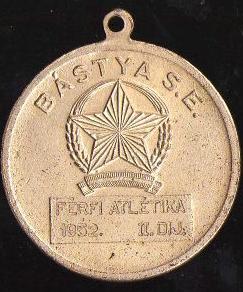 0
0 -
I don't throw the word "rare" around much, but this is quite rare. It's a small stick-pin type, two piece badge for membership in the Bástya S. E. (Bástya Sport Egyesület - Bastion Sport Association)-the sport club of the AVO (Border Guard) / AVH (Security Police) during the Rakosi era (1949-1956). In 1956, the Dozsa (Doge... more or less synonymous with "bastion") became it's successor as the sport club throughout the Internal Ministry (I have a couple of those pins in transit- they have a much more familiar look).
The workmanship is superb on this badge, which is only a little taller than a US nickle. The term "exquisite" comes to mind. Note the usage of the AVH/AVO cap badge emblem.
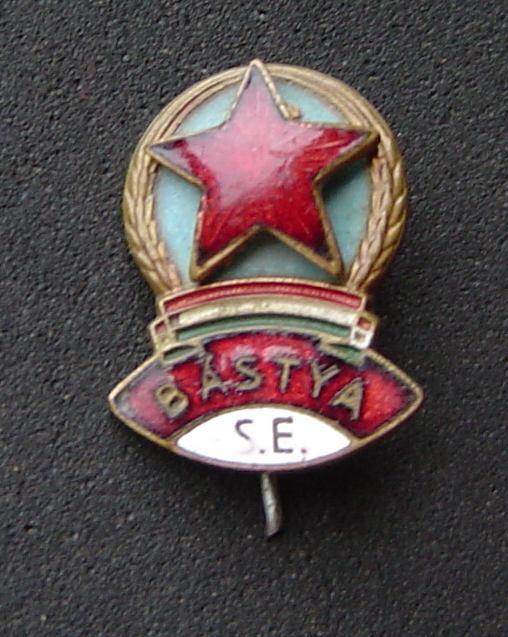 0
0 -
Shoot me a PM... we'll talk. :whistle:
0 -
Yet another suspended star design... the Excellent Dam Worker (not damned worker
 ).
). 0
0 -
Nice case! Wish I had one for mine (really makes a difference).
Here's a cased Excellent Worker in the Mining Industry badge and miniature. This is the first case I've encountered that actually has a recess for the mini. Judging by the case (same scuff as Stogieman's above; no seal but a rectangular "moulding" around the top) I would say it's from the later '50's/early '60's. Due to the "glare" when photographing gilt against white enamel, I've included a second shot of the lettering.

 0
0 -
I don't believe it's genuine for the following reasons:
1. There's an extra bead of solder, especially seen from the back, just where the medal and ring meet- very sloppy for Mondvor. Also, the ring seems a bit large.
2. There are feint lines in two areas of the date, indicating an uneven-ness of the background.
3. All elements of the type (lettering) should be at the same height from the background. I see some deviation in places.
4. The sun rays should also be at the same height from the background- it's easy to see that several aren't.
5. There seems to be a slightly beveled edge- the edge should be perfectly flat and at a 90 degree angle to the medal face. A beveled, polished edge can hide a casting.
6. While this could have been changed by the veteran- and many were by those who remained in the service after the war- the new suspension bothers me.
7. Looks like the "lip" (around the medal's edge) has been ground off the backside and polished over. Pretty easily seen.
At $15.50, this shouldn't hurt too much. Sorry...
0 -
Yeah Charles, I've seen these instances in all the countries I collect with the exception, oddly, of Bulgaria.
-USSR: very limited production of the Order of Victory (24 awarded- I believe that number is correct).
-DDR: prototypes abound here, both of badges and of medals/orders... probably due to outsourcing rather than using a "state mint".
-Mongolia: limited production on Honourary Freeman of Mongolia... one awarded (Breznev).
- Romania: virtually all higher orders made in plated brass for most awardees; precious metals for the select few, especially after 1965.
Just makes what we do all the more interesting.
0 -
Cimbineus,
The more I look at that badge, the more I come to the conclusion that it must be either:
A. An example (sample) of a complete badge change that never made full production because of the Karhatalom being disbanded. Or...
B. A "one-off" award for the commander of the unit prior to the disbanding (sort of a "hand-shake" type recognition of service).
At any rate, a beautiful badge.
0 -
Wow, nice badge. I see the Hungarian plastic star has been brought into play here. While I understand the rarity of the piece, as well as the value of something of which so few were made, I think I'd rather find a Rakosi era badge as you've shown on the upper left. The crossed PPH and Mosin-Nagant make it for me!
0 -
A final image of the set in case. The badge has a form fitting (even for the prongs) recess while the miniature doesn't- it's just placed here for the photo.
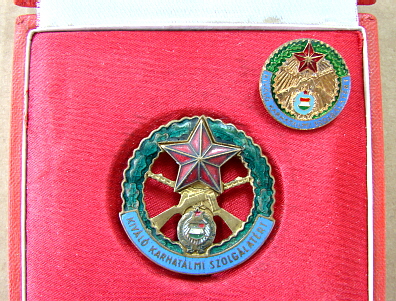 0
0 -
on to the miniature... gilt plated and standard pin back.
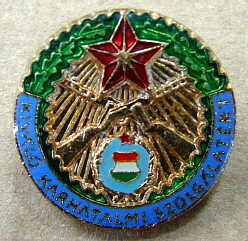
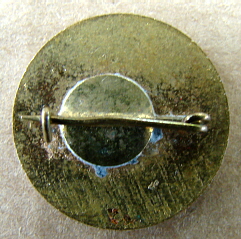 0
0 -
The back...
 0
0 -
On to the badge itself. There are some enamel issues within the Kadar seal but, all in all, the badge is in very good shape. The back features the "opposing prong" type attachment.
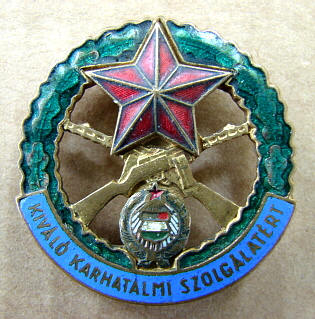 0
0 -
The Excellent State Security Police set has arrived! Gordon- the case is completely (top and bottom) covered in a red leatherette. No distinguishing mark or seal either printed or embossed on the top; the same leatherette covers the "scuff". It is, however, a very sturdy case with a metal latch and two metal hinges.
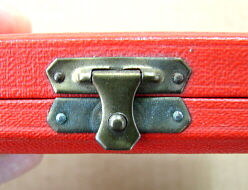
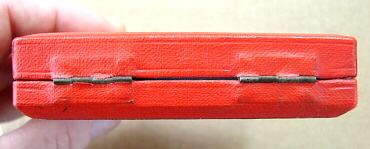 0
0 -
Thanks Charles! So medal=service; badge=performance in the civilian sector. Got it!:jumping:
0 -
Here's a Kiváló Bányász (Excellent Miner) badge from 1954, which I've also posted in the Kivalo Dolgozol badge thread. A three piece badge, it's construction is very similar to many medals of the era. What I don't know is if the medal I posted at the beginning of this thread would have taken the place of this badge or if the two were awarded during the same time period.

 0
0 -
A detail of the front of the medal itself. I really like the Hungarian use of the "cut-out" design.
 0
0 -
I had a devil of a time tracking one of these down, until I figured out it was awarded over a span of less than a year. It's a Rakosi period Meritorious Mining Service Medal, Bronze grade. It was began in early 1956... later that same year was the failed revolution and, after 1957, the same medal continued but with the Kadar arms (fairly easy to get). The Bronze grade was for 10 years service in the mines or 15 years service for mine-related work. The time was retroactive to 4 April 1945 so you can see that this was the only grade that could have been awarded, even though Gold and Silver were, as far as I know, made.
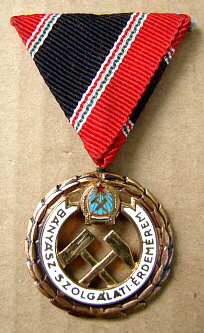
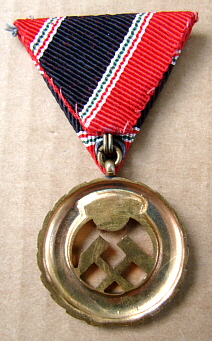 0
0 -
A beautifully enameled front gives way to a pretty standard pin back.
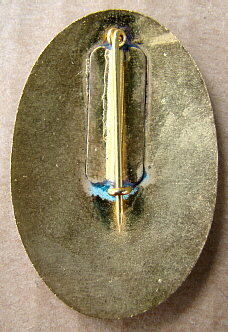 0
0 -
Finally, for now, an Érdemes Vasutas (Distinguished Railwayman) from 1952.
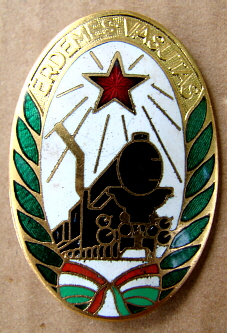 0
0 -
And the back...
 0
0 -
An Az Egészségügy Kiváló Dolgozója (Excellent Worker of the Public Health) badge from 1953.
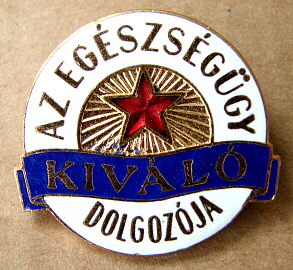 0
0



Hungarian Kivalo Dolgozol Badges
in Central & Eastern European States
Posted
I believe this will fit here... the Stalin Iron Works (now Danube Iron Works) in Dunapentele were built between 1950-54. The Minister of Smelter and Machine Industry founded the medal in 1951 to award those who distinguished themselves in the construction works. The 1st class (silver) could be awarded after 2 years of work and the 2nd class (bronze) after 1 year. The hanger on this example reads Metallurgy Minister.